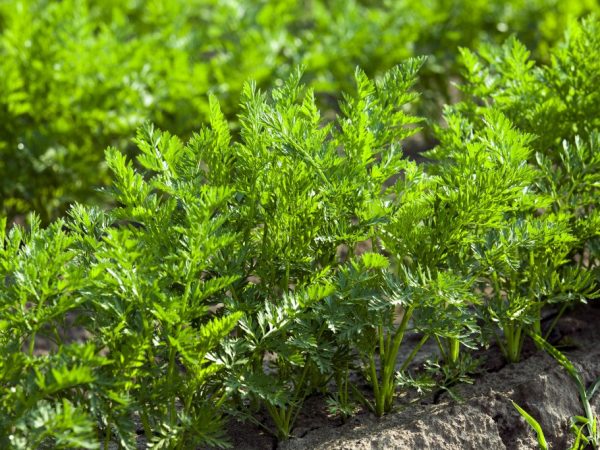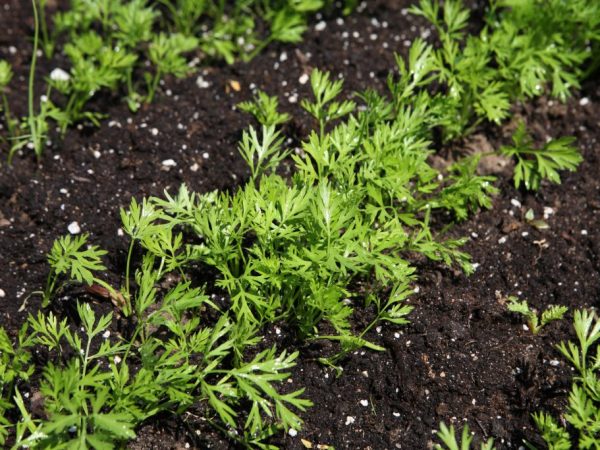Fertilizing carrots after germination
Fertilizing carrots after germination lays the future development of vegetable crops, ensures its active growth and a good harvest.

Fertilizing carrots after germination
What is necessary for seedlings
At the initial stage of development, carrot seedlings need a number of elements:
- Nitrogen. With its help, the green mass is increased, and with its lack, the carrot foliage becomes smaller, the roots grow small in size.
- Potassium. This element is responsible for the process of photosynthesis in foliage, without which the production of organic substances in plant cells is impossible. Lack of potassium leads to a decrease in carrots' resistance to diseases,
- Phosphorus. With its lack, young shoots of carrots do not tolerate the hot conditions of summer, as a result, the root crops are low-juiced and tasteless.
Application rates
The application rates of fertilizer complexes containing the necessary elements for feeding young carrot seedlings depend on the quality of the soil:
- for sod and podzolic soil, 6-9 g of nitrogen and phosphorus are applied, potassium - 15-18 g,
- for meadow land, 4-6 g of nitrogen, 6-9 g of phosphorus, 18-21 g of potassium are introduced,
- for leached and black earth soils, add 3-6 g of nitrogen, 6-8 g of phosphorus, 9-12 g of potassium,
- for peat and swampy lands, up to 3 g of nitrogen, 9-12 g of phosphorus, 18-25 g of potassium are introduced.
Frequency and time of feeding

Fertilize carrots in 2-3 weeks
Watering and spraying carrots after germination is required at least 2-3 times, especially if the soil is not rich in nutrients or climatic conditions are unfavorable: there are often rains or droughts, frosts.
Under favorable conditions for growing a vegetable crop, feeding carrots after germination begins no earlier than 3 weeks after the emergence of sprouts. Secondary application of fertilizing complexes is carried out after 2-3 weeks after the initial feeding.
For an increased result from top dressing, weeds are destroyed by actively using herbicides.
Fertilization when thinning
The time for feeding carrots after the emergence of shoots is tied to the procedure for thinning young shoots. It is held twice:
- when 2-3 leaves are observed in sprouts, usually the age of such young plantings is about 20 days,
- when sprouts have 5-6 true leaves.
Formulations of dressings and application rules
As a top dressing of carrot seedlings after their appearance, it is permissible to use the following solutions:
- nitrophoska diluted with water in a proportion of 1 tbsp. for 10 l,
- wood ash at the rate of 5-7 st. l. for 10 liters of water,
- a mixture of potassium nitrate (20 g), urea (15 g), double superphosphate (15 g) per 10 liters of water,
- manure diluted in water, in a ratio of 1:10,
- chicken manure, from which a concentrate is preliminarily made from 1 part of organic fertilizer to 10 parts of water; then the concentration is reduced by increasing the total volume of the working fluid by a factor of 10.
When combining the feeding of carrot seedlings and the procedure for their thinning at each stage, they use different fertilizing compositions:
- at the initial thinning of plantings, an infusion of weeds is used, diluted in water in a ratio of 1: 5, where potassium sulfate or carbonate is mixed: 1-2 tbsp. l. for 10 liters of water,
- at the second thinning, they are limited to watering with a working solution with potassium: 3 tbsp. l. for 10 liters of water.
Application rules
It is permissible to use both root and foliar post-emergence bait. It should be borne in mind that:
- the right time for fertilizing is morning or evening,
- immediately before applying fertilizers, the soil is loosened and watered abundantly.
Conclusion
Fertilizing carrots after the appearance of the first shoots is an important measure that establishes the health of the vegetable crop, ensures its full development and growth, and leads to good yields. Fertilizers are applied in accordance with the recommended rates on time and with the required frequency.


